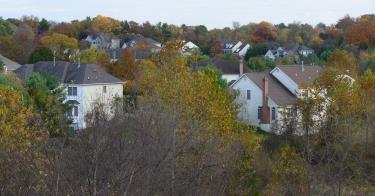“No matter where you are from, we’re glad you’re our neighbor.” “Hate has no home here.” These and similar lawn signs are common in my Montgomery County neighborhood.
That’s why I’m shocked at the backlash to the Montgomery County Council’s proposal to slightly scale back its heavy-handed restrictions on accessory dwelling units (ADUs). The “not in my backyard” responses reveal a skin-deep level of acceptance for anyone not like them.
ADUs are small accessory apartments, often characterized as “granny flats” or “English basements.” In Montgomery County, they are few and far between — only 475 licensed ADUs out of 175,000 single-family homes and 369,000 total housing units.
Recognizing the extremely high cost of housing in Montgomery County, as well as many families’ desire to keep aging parents or kids just starting out on their own nearby, the County Council proposed relaxing the current rules that prevent most residents from being able to build an ADU on their property.
For example, the council proposed, in limited instances, to remove the requirement to provide an additional parking space. It also proposed letting ADUs be built on most single-family lots (so long as they do not take up more than 10 percent of the lot), instead of only on lots of one-acre or more.
And it would eliminate the restriction that homeowners cannot add an ADU if one of their neighbors already has one.
Some residents’ reactions have been nothing short of economic prejudice. One resident called the proposal “a slap in the face to those people who have worked hard to build a comfortable home and neighborhood.” This characterization assumes that everyone residing in an ADU is an “outsider,” as opposed to a family member or friend of the homeowner.
And what if ADUs do bring in lower-than-neighborhood-average-income residents? Must the county subscribe to the elitist assumption that incomes are directly correlated to people’s efforts and have nothing to do with the advantages or disadvantages they’ve faced in life?
Other residents have gone even further down the fearmongering trail, suggesting that this proposal would convert Montgomery County from a sheltered suburb to a shantytown. On a neighborhood listserv of mine, one resident conjured up all sorts of adverse consequences, from overcrowded schools all the way to (wait for it) human trafficking.
Let’s look at the overcrowding argument: More people on a property does seem like it could lead to increased school enrollment. But it turns out that properties with ADUs don’t actually have significantly more children. Considering the very slight difference (an average of 0.464 children per property with an ADU vs. 0.462 for properties without ADUs), it would take 500 new ADUs to add just one child to the public schools.
What about the consequences for neighbors? Yes, an ADU could be an eyesore, it could mean another car on the street or its occupants might generate some additional noise. But the proposal contains a natural check on these concerns: a requirement that the property owner live on premises if the property has an occupied ADU.
And then there’s the senseless suggestion that removing the limit on the number of children living in an ADU (while still maintaining the total occupancy cap) could lead to “human trafficking problems.” Human traffickers disdain the most fundamental human rights and have no compunction about breaking the law. It’s unlikely that a tweak to existing law would embolden them to traffic more people.
Instead of trying to incite unwarranted fear and concerns among residents, those who oppose this measure should be honest about their reasons.
Katherine C. Gugulis candidly stated her concerns when she wrote in The Post, “Just because others flee crime-ridden and poverty-stricken areas doesn’t mean Montgomery County has to be turned into a slum to accommodate them.”
If that’s what happens when we allow people trying to escape poverty, violence and persecution to enter into an area with greater wealth and affluence than that which they flee, then why allow any refugees to enter the United States? And why not restrict immigration to wealthy and well-educated individuals and families?
Excessive zoning laws are just a less ostensible form of economic segregation.
On a personal and more positive note, I can report that my own Montgomery County neighbors have been welcoming and openhearted to having another family — who neither looks like us nor could afford to live in our neighborhood — live on our property.
As a county that prides itself on inclusion and support of families, I hope that Montgomery County residents who oppose these revisions to accessory dwelling units will reconsider their fears. We all have a lot to learn by opening our doors to family members, friends, strangers and especially the less-advantaged.
This piece originally appeared in The Washington Post




